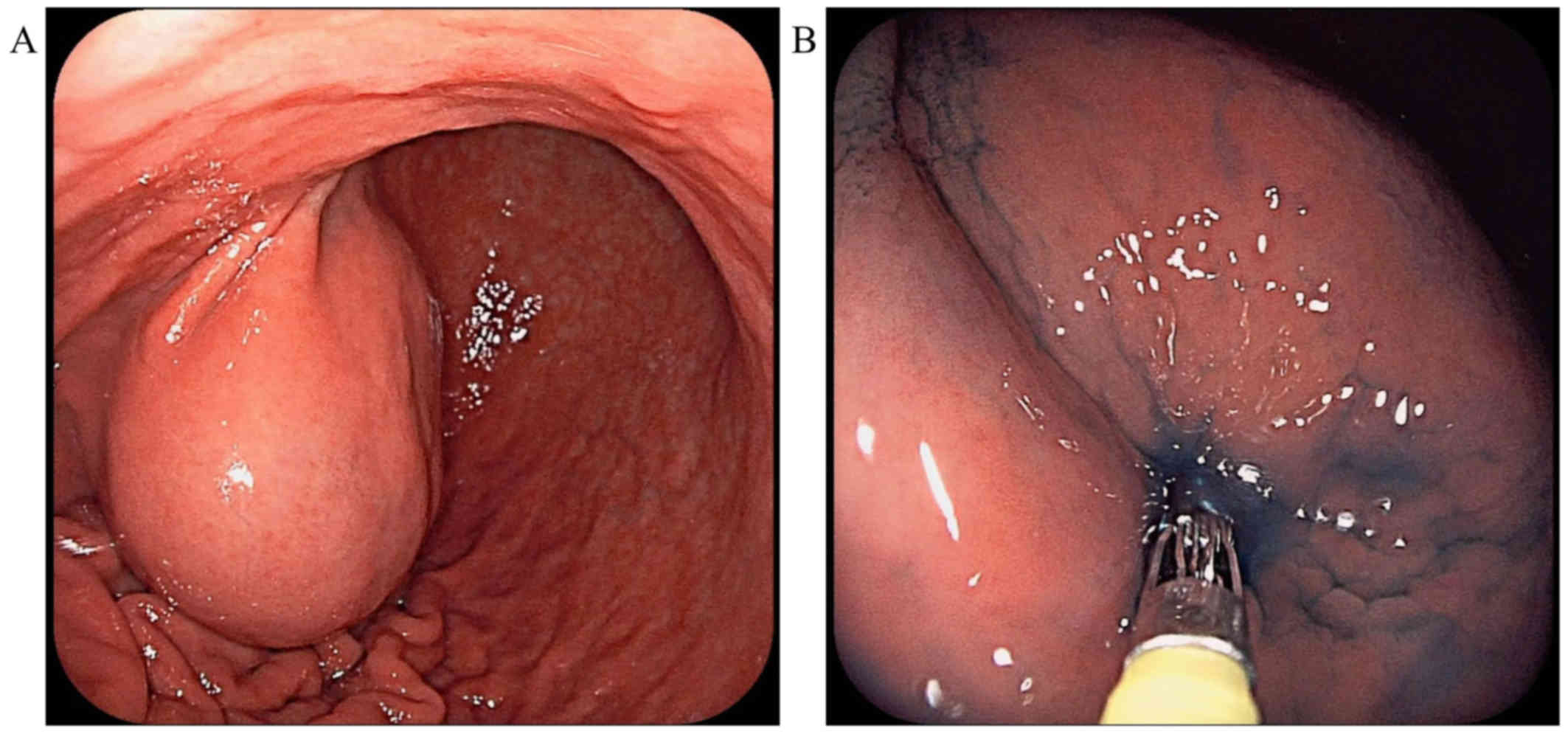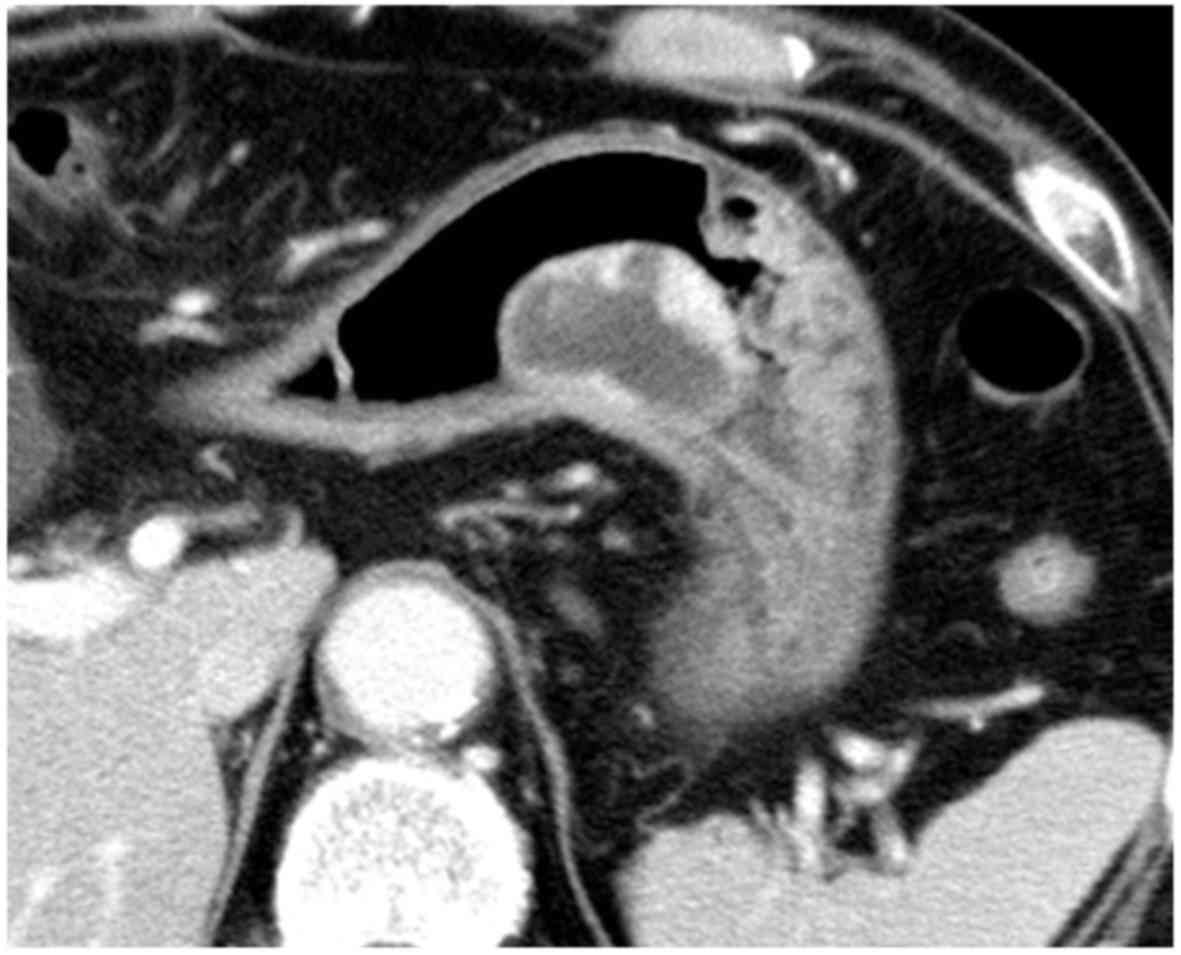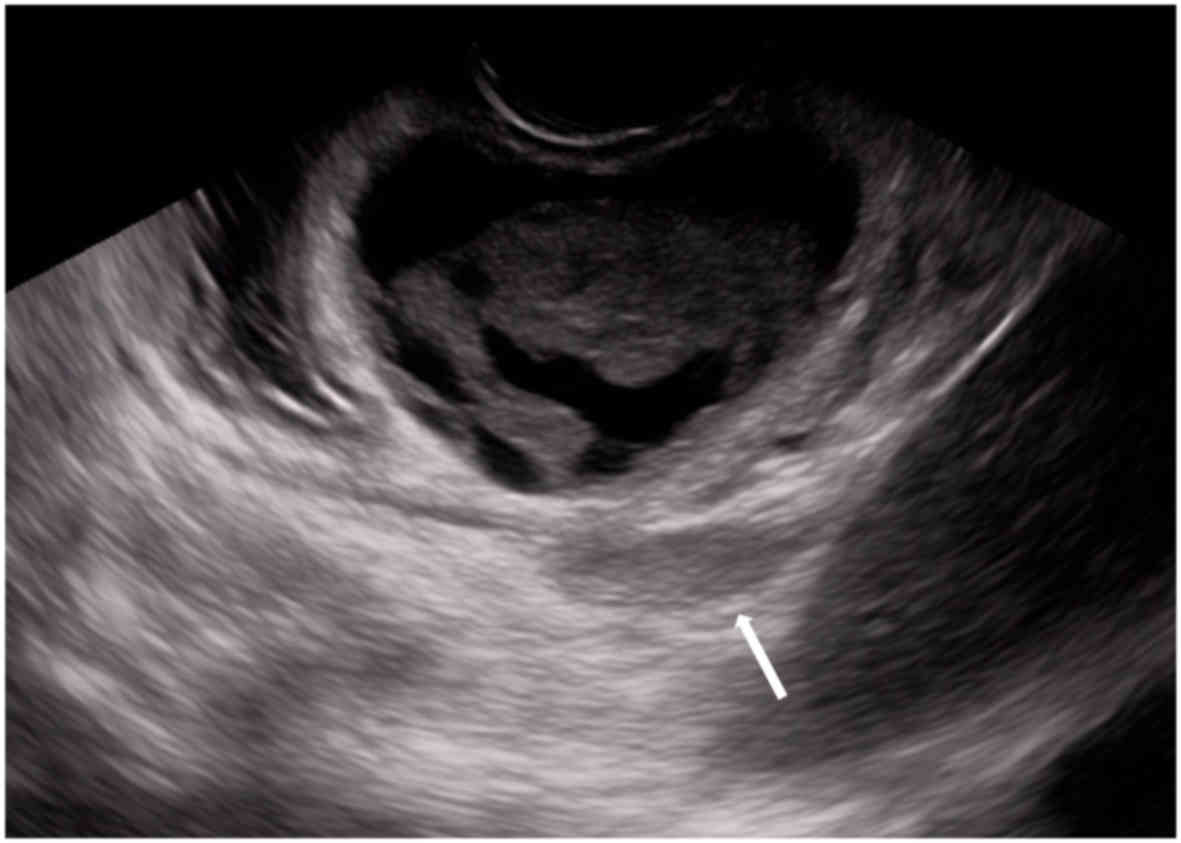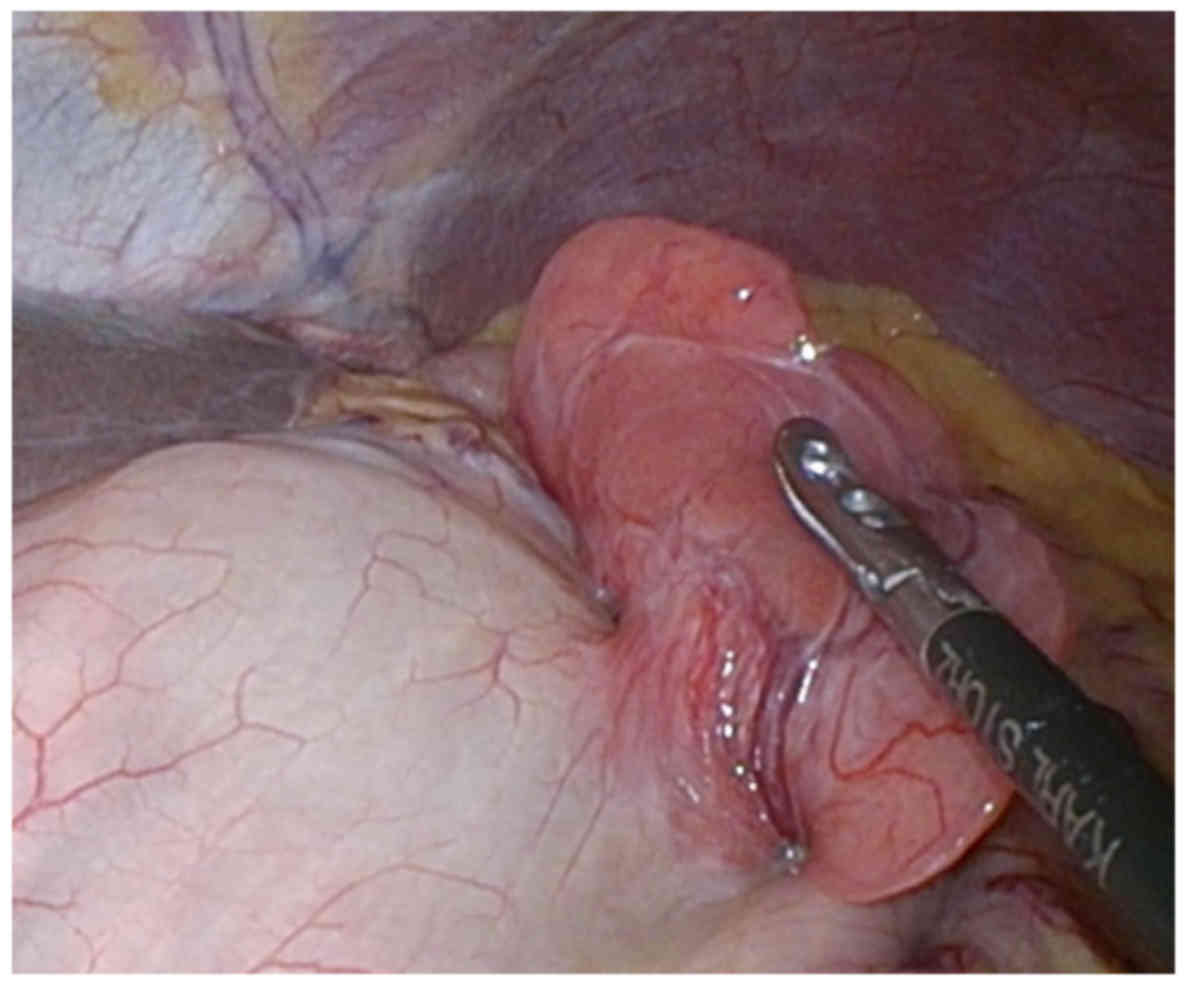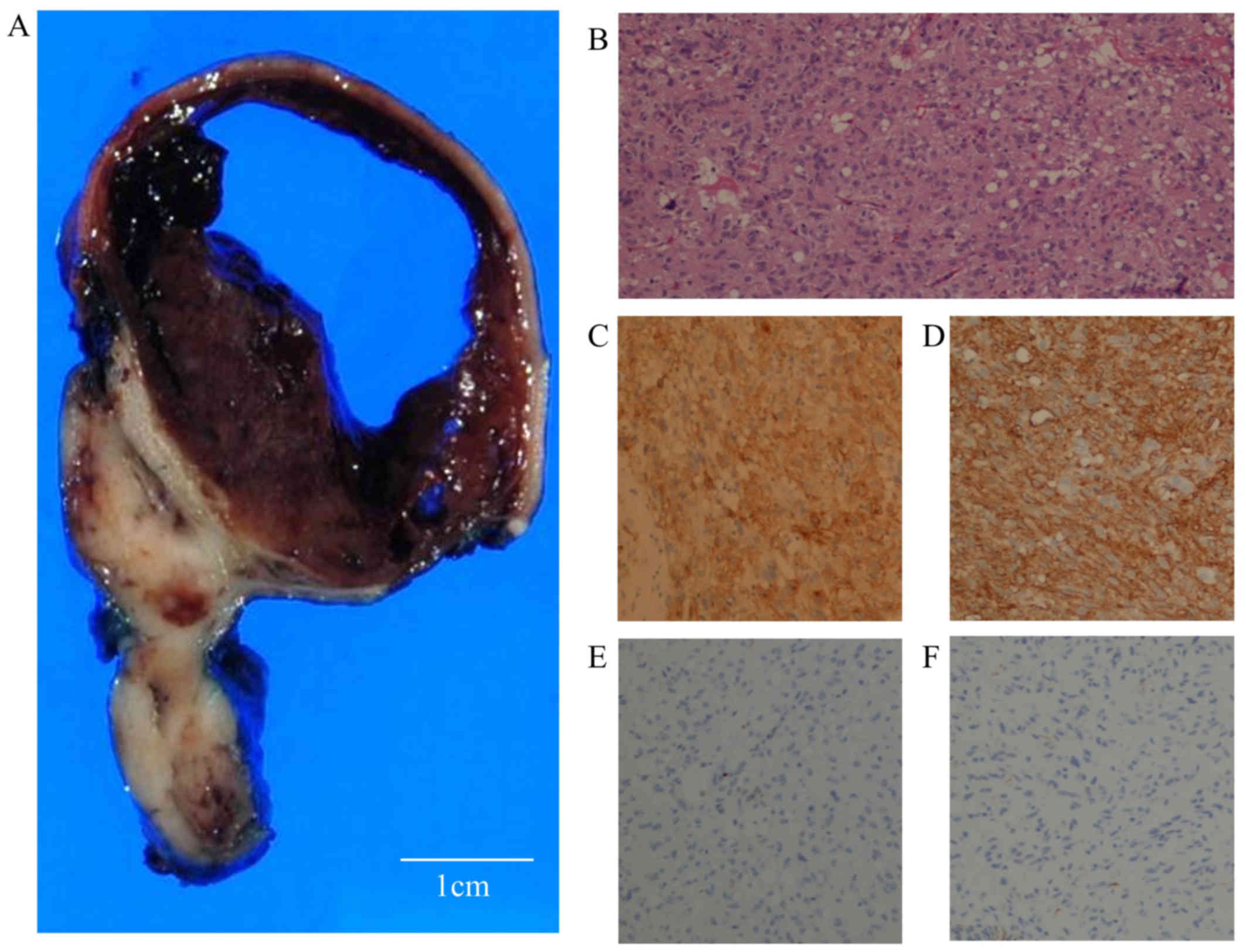Atypical presentation of a cushion sign-positive stomach gastrointestinal stromal tumor with cystic formation: A case report
- Authors:
- Published online on: May 25, 2018 https://doi.org/10.3892/mco.2018.1639
- Pages: 168-172
-
Copyright: © Okagawa et al. This is an open access article distributed under the terms of Creative Commons Attribution License.
Abstract
Introduction
Gastrointestinal stromal tumors (GISTs) are the most common type of mesenchymal neoplasms that originate from the interstitial cell of Cajal (1,2). Most of these tumors originate from the stomach (60%), followed by the small intestine (30%), and the colon (5%) (3). GISTs are classified as intramural, exoluminal, endoluminal, or mixed types, according to tumor location (4). GISTs are considered to have malignant potential, and several risk classifications have been proposed (5–7). Recently, Joensuu's classification system, which includes tumor size, mitotic figures, organ of origin, and presence of rupture, is often used (7). Typically, GISTs appear as solid masses and rarely present with cystic formations (8–16). The cystic formation is reportedly caused by hemorrhage or necrosis (17). Most stomach GISTs with cystic formations progress with an exoluminal or intramural pattern and are frequently misdiagnosed as epigastric cystic tumors derived from the pancreas or liver (13,15,16). Cushion sign refers to the morphometric fluctuation of the submucosal tumor by forceps compression (18), which is generally a characteristic of very soft or cystic tumors, such as lipomas or lymphangiomas. We report a rare case of a cushion sign-positive stomach GIST with cystic formation, which mainly developed inside the stomach.
Case report
A 72-year-old male, with a past medical history of gastric ulcer, was referred to our hospital for further examination of an abnormality in the stomach that was found by an esophagogastroduodenoscopy (EGD) performed for a health checkup. He had no abdominal symptoms, and his blood tests were normal, including levels of carcinoembryonic antigen and carbohydrate antigen 19-9 tumor markers. EGD revealed a mass covered by normal mucosa with a bridging fold, approximately 50 mm in diameter, at the anterior wall of the gastric angle (Fig. 1A). The submucosal tumor (SMT) was round and smooth, without erosions or ulcers. The SMT was very soft, with positive cushion sign when we used forceps to compress the tumor (Fig. 1B). The mass was thought to be a benign tumor, such as a lymphangioma, because the inside of the tumor was considered to contain liquid. However, contrast-enhanced abdominal computed tomography (CT) showed a mass containing both cystic and solid areas, mainly growing inside the stomach, and revealed enhancement of the solid portion and peripheral rim of the tumor (Fig. 2). Furthermore, endoscopic ultrasound (EUS) using a convex-type scope revealed a cystic tumor with solid component located in the third to fourth layer of the stomach and part of the solid component that had developed outside the stomach (Fig. 3). The cystic component appeared as low-level echoes. Subsequently, EUS-fine needle aspiration (EUS-FNA) of the solid component was performed for definitive diagnosis. Histologically, specimens obtained via EUS-FNA included spindle tumor cells. Immunohistochemical analysis of the specimens revealed that they were diffusely positive for c-kit and CD34; therefore, the tumor was diagnosed as GIST. However we considered laparoscopic partial gastrectomy or laparoscopic and endoscopic cooperative surgery (LECS) to treat the tumor, we employed LECS for more reliable resection. The patient underwent LECS to remove the GIST. Intraoperative laparoscopic findings showed soft tissue arising from the anterior wall of the stomach, freely mobile in the peritoneal cavity (Fig. 4). Although the lesion was located at the serosa side of the gastric SMT, there were no findings of peritoneal dissemination. The tumor was completely removed, and no intraoperative or postoperative complications were observed. The patient was discharged from our hospital within a week.
Macroscopically, the mass measured 57×51×13 mm, comprising both solid and cystic regions (Fig. 5A). Most of the tumor seen on endoscopy was the cystic component, which was filled with bloody serous fluid. Histopathological findings revealed that the tumor was located in the submucosal to muscularis layer of the stomach, and the cystic component was located in the submucosal layer. The cystic component showed hemorrhage, but no necrosis. Although part of the tumor projected toward the serosa, forming the lesion as seen on laparoscopy, there were no findings of serosal invasion. Histopathological analysis of the tumor revealed the spindle cells (Fig. 5B). The tumor cells were immunostained with anti-c-kit (CA4502, 1:200 dilution; Dako Japan, Tokyo, Japan), CD34 (NCL-L-END, 1:800 dilution), S-100 (NCL-L-S100p, 1:100 dilution), desmin (NCL-L-DES-DERII, 1:100 dilution), and smooth muscle actin (SMA) (NCL-L-SMA, 1:200 dilution) (all from Leica Biosystems, Newcastle, UK). These cells were positive for c-kit and CD34 (Fig. 5C and D), and negative for S-100, desmin (Fig. 5E and F) and SMA, and the mitotic count was 2/50 high-power fields. The tumor was diagnosed as a mixed-type GIST with cystic formation, belonging to the intermediate-risk group, based on Joensuu's classification system. The patient received no adjuvant therapy and continues to do well without recurrence for 40 months after LECS. Written informed consent for this case report was obtained from the patient.
Discussion
Cysts are macroscopically identified in ~50% of GISTs (19); however, stomach GISTs are usually solid tumors and seldom exhibit predominant cystic formations clinically. A few reported cases developed cystic changes, and the majority of these were cases of large GISTs, progressing as exoluminal or intramural patterns and misdiagnosed as epigastric cystic tumors derived from other organs (Table I). In the present case, most of the tumor developed inside the stomach, with positive cushion sign, and presented unique form. To our best knowledge, this is the first case to report a cushion sign-positive stomach GIST presented in an atypical form. The cystic space of GIST is reportedly formed by hemorrhage or necrosis (17). Hypervascular tumors may lead to internal bleeding, and necrosis can be caused by recurrent congestion, hemorrhage, or edema when the tumors grow faster than the capacity of blood supply or vein drainage (20). In the present case, the cystic component contained bloody serous fluid, without necrosis. This tumor might tend to have hemorrhage because of the presence of numerous blood vessels pathologically.
The Japanese guidelines for gastric SMT recommend detailed examination with CT with contrast enhancement, EUS, and/or EUS-FNA when SMTs are 2–5 cm in diameter (21). In addition, EUS is reported to be useful modalities for diagnosing GISTs with cystic formation (14). In the present case, we initially thought the tumor was a lymphangioma, as the SMT was very soft and cushion sign was positive. However, it was highly important to conduct contrast-enhanced CT, EUS and EUS-FNA, according to the guidelines. Recently, LECS has developed as a safe and feasible procedure for the resection of gastric SMTs (22), and we selected tumor removal using LECS. The laparoscopic findings showed that part of GIST was arising from the gastric wall, which was the lesion outside the stomach as seen on EUS. EUS was also a useful modality for diagnosing the extension of GIST in this case.
In the present case, GIST belonged to the intermediate-risk group due to the tumor size. However, some reports have suggested that the real tumor volume may be smaller than the imaging volume on cases of cystic GIST (13,23). It is controversial that a component of cystic lesion is included in the tumor size. Examination of additional cases is necessary for accurate risk classification of GIST with cystic formation.
For high-risk group of GIST, administration of imatinib for 3 years is recommended as adjuvant chemotherapy (24), and the effect of imatinib has been identified to be related to c-kit and PDGFR mutations (25). Because this case belonged to the intermediate-risk group, we did not search those mutations. However, if this case recurs in the future, it is important to examine these mutations.
In conclusion, we reported a rare case of a cushion sign-positive stomach GIST with cystic formation. This case suggests that the possibility of cystic formation of malignant tumor, such as GIST, should be kept in mind when the tumor is large and has a solid component, even if it appears as a cushion sign-positive SMT.
Acknowledgments
Not applicable.
Funding
No funding was received.
Availability of data and materials
Not applicable.
Authors' contributions
YOk, TS and HK conceived of the study and participated in its design and coordination and analyzed and interpreted the data. YOk, TS and HK wrote the manuscript. TS, HI, SO, KT, MY, RF, TM, KM, MH performed technical work. YOy performed histological examination. YK, SK and SO performed the surgery.
Ethics approval and consent to participate
Written informed consent for this case report was obtained from the patient.
Consent for publication
Written informed consent was obtained from the patient for publication of this case report and any accompanying images.
Competing interests
The authors declare that they have no competing interests.
References
|
Joensuu H, Hohenberger P and Corless CL: Gastrointestinal stromal tumour. Lancet. 382:973–983. 2013. View Article : Google Scholar : PubMed/NCBI | |
|
Nowain A, Bhakta H, Pais S, Kanel G and Verma S: Gastrointestinal stromal tumors: Clinical profile, pathogenesis, treatment strategies and prognosis. J Gastroenterol Hepatol. 20:818–824. 2005. View Article : Google Scholar : PubMed/NCBI | |
|
Nishida T, Goto O, Raut CP and Yahagi N: Diagnostic and treatment strategy for small gastrointestinal stromal tumors. Cancer. 122:3110–3118. 2016. View Article : Google Scholar : PubMed/NCBI | |
|
Joensuu H: Risk stratification of patients diagnosed with gastrointestinal stromal tumor. Hum Pathol. 39:1411–1419. 2008. View Article : Google Scholar : PubMed/NCBI | |
|
Fletcher CD, Berman JJ, Corless C, Gorstein F, Lasota J, Longley BJ, Miettinen M, O'Leary TJ, Remotti H, Rubin BP, et al: Diagnosis of gastrointestinal stromal tumors: A consensus approach. Hum Pathol. 33:459–465. 2002. View Article : Google Scholar : PubMed/NCBI | |
|
Miettinen M and Lasota J: Gastrointestinal stromal tumors: Pathology and prognosis at different sites. Semin Diagn Pathol. 23:70–83. 2006. View Article : Google Scholar : PubMed/NCBI | |
|
Joensuu H, Vehtari A, Riihimäki J, Nishida T, Steigen SE, Brabec P, Plank L, Nilsson B, Cirilli C, Braconi C, et al: Risk of recurrence of gastrointestinal stromal tumour after surgery: An analysis of pooled population-based cohorts. Lancet Oncol. 13:265–274. 2012. View Article : Google Scholar : PubMed/NCBI | |
|
Park J, Rubinas TC, Fordham LA and Phillips JD: Multifocal gastrointestinal stromal tumor (GIST) of the stomach in an 11-year-old girl. Pediatr Radiol. 36:1212–1214. 2006. View Article : Google Scholar : PubMed/NCBI | |
|
Osada T, Nagahara A, Kodani T, Namihisa A, Kawabe M, Yoshizawa T, Ohkusa T and Watanabe S: Gastrointestinal stromal tumor of the stomach with a giant abscess penetrating the gastric lumen. World J Gastroenterol. 13:2385–2387. 2007. View Article : Google Scholar : PubMed/NCBI | |
|
Cruz RJ Jr, Vincenzi R, Ketzer BM, Cecilio AL and Cepeda LA: Spontaneous intratumoral bleeding and rupture of giant gastric stromal tumor (> 30 cm) in a young patient. World J Surg Oncol. 6:762008. View Article : Google Scholar : PubMed/NCBI | |
|
Yu CC, Wu CC, Hwang JI, Wang J and Chang CS: Thick calcification from a GIST of the stomach penetrating into pericolic soft tissue-report of a case. World J Surg Oncol. 9:452011. View Article : Google Scholar : PubMed/NCBI | |
|
Notani H, Kawamura T, Sato T, Hoshino A, Sato Y and Nakajima A: A case of a giant gastrointestinal stromal tumor of the stomach with extramural growth. Gan To Kagaku Ryoho. 40:2179–2181. 2013.(In Japanese). PubMed/NCBI | |
|
Zhu CC, Liu Y and Zhao G: Exophytic gastrointestinal stromal tumor with cystic changes: A case report. Oncol Lett. 7:1427–1429. 2014. View Article : Google Scholar : PubMed/NCBI | |
|
Okano H, Tochio T, Suga D, Kumazawa H, Isono Y, Tanaka H, Matsusaki S, Sase T, Saito T, Mukai K, et al: A case of a stomach gastrointestinal stromal tumor with extremely predominant cystic formation. Clin J Gastroenterol. 8:197–201. 2015. View Article : Google Scholar : PubMed/NCBI | |
|
Hamza AM, Ayyash EH, Alzafiri R, Francis I and Asfar S: Gastrointestinal stromal tumour masquerading as a cyst in the lesser sac. BMJ Case Rep. 2016:bcr20162154792016. View Article : Google Scholar : PubMed/NCBI | |
|
Sun KK, Xu S, Chen J, Liu G, Shen X and Wu X: Atypical presentation of a gastric stromal tumor masquerading as a giant intraabdominal cyst: A case report. Oncol Lett. 12:3018–3020. 2016. View Article : Google Scholar : PubMed/NCBI | |
|
Levy AD, Remotti HE, Thompson WM, Sobin LH and Miettinen M: Gastrointestinal stromal tumors: Radiologic features with pathologic correlation. Radiographics. 23:283–304, 456, quiz 532. 2003. View Article : Google Scholar : PubMed/NCBI | |
|
de Beer RA and Shinya H: Colonic lipomas. An endoscopic analysis. Gastrointest Endosc. 22:90–91. 1975. View Article : Google Scholar | |
|
Miettinen M, Furlong M, Sarlomo-Rikala M, Burke A, Sobin LH and Lasota J: Gastrointestinal stromal tumors, intramural leiomyomas, and leiomyosarcomas in the rectum and anus: A clinicopathologic, immunohistochemical, and molecular genetic study of 144 cases. Am J Surg Pathol. 25:1121–1133. 2001. View Article : Google Scholar : PubMed/NCBI | |
|
Andea AA and Klimstra DS: Adenocarcinoma arising in a tailgut cyst with prominent meningothelial proliferation and thyroid tissue: Case report and review of the literature. Virchows Arch. 446:316–321. 2005. View Article : Google Scholar : PubMed/NCBI | |
|
Nishida T, Hirota S, Yanagisawa A, Sugino Y, Minami M, Yamamura Y, Otani Y, Shimada Y, Takahashi F and Kubota T; GIST Guideline Subcommittee: Clinical practice guidelines for gastrointestinal stromal tumor (GIST) in Japan: English version. Int J Clin Oncol. 13:416–430. 2008. View Article : Google Scholar : PubMed/NCBI | |
|
Matsuda T, Nunobe S, Kosuga T, Kawahira H, Inaki N, Kitashiro S, Abe N, Miyashiro I, Nagao S, Nishizaki M, et al: Society for the Study of Laparoscopy and Endoscopy Cooperative Surgery: Laparoscopic and luminal endoscopic cooperative surgery can be a standard treatment for submucosal tumors of the stomach: A retrospective multicenter study. Endoscopy. 49:476–483. 2017. View Article : Google Scholar : PubMed/NCBI | |
|
Joensuu H, Eriksson M, Sundby Hall K, Hartmann JT, Pink D, Schütte J, Ramadori G, Hohenberger P, Duyster J, Al-Batran SE, et al: One vs three years of adjuvant imatinib for operable gastrointestinal stromal tumor: A randomized trial. JAMA. 307:1265–1272. 2012. View Article : Google Scholar : PubMed/NCBI | |
|
Joensuu H, Eriksson M, Sundby Hall K, Hartmann JT, Pink D, Schütte J, Ramadori G, Hohenberger P, Duyster J, Al-Batran SE, et al: One vs three years of adjuvant imatinib for operable gastrointestinal stromal tumor: A randomized trial. JAMA. 307:1265–1272. 2012. View Article : Google Scholar : PubMed/NCBI | |
|
Frolov A, Chahwan S, Ochs M, Arnoletti JP, Pan ZZ, Favorova O, Fletcher J, von Mehren M, Eisenberg B and Godwin AK: Response markers and the molecular mechanisms of action of Gleevec in gastrointestinal stromal tumors. Mol Cancer Ther. 2:699–709. 2003.PubMed/NCBI |



